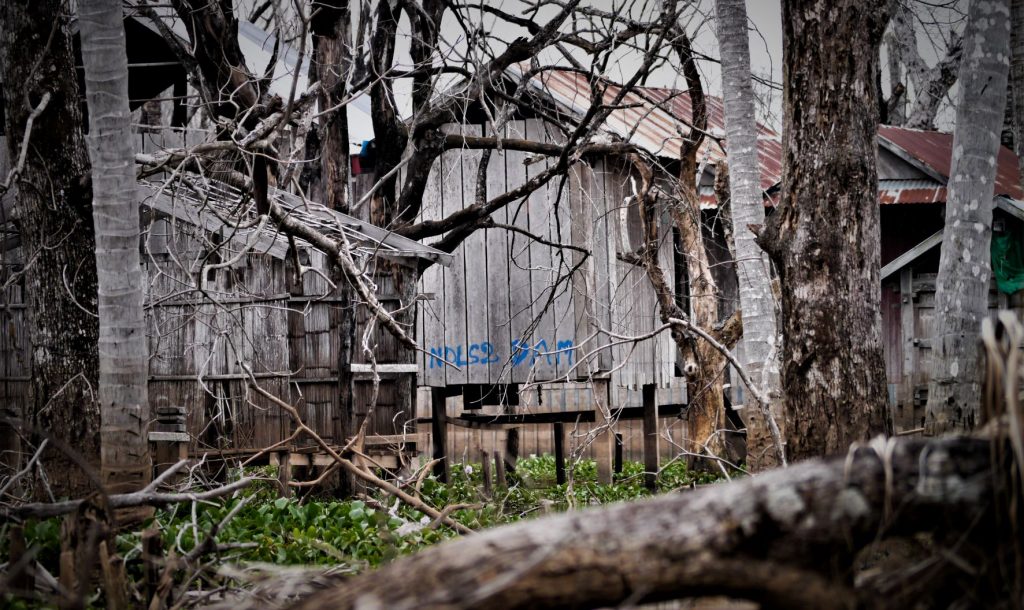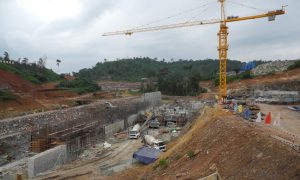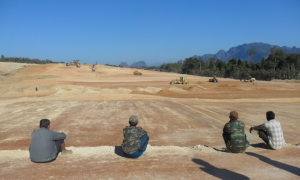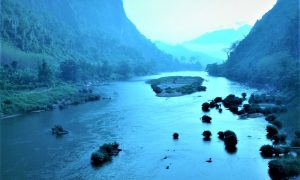Recently, a group of advocates, NGO workers and scholars working in the Mekong region gathered to discuss the far-reaching and compounding impacts of hydropower dams on regional environments and societies. Using the notion of rupture as a way to explore dramatic socio-ecological change, and its consequences, this gathering included a sobering discussion of current pressures faced by civil society in Mekong countries.
Just as the Mekong river has been controlled and curtailed by dams, so have the voices of civil society actors who contest environmental and social injustices in the region. Such contestation is not just about dams, but also about land, resources, and rights.
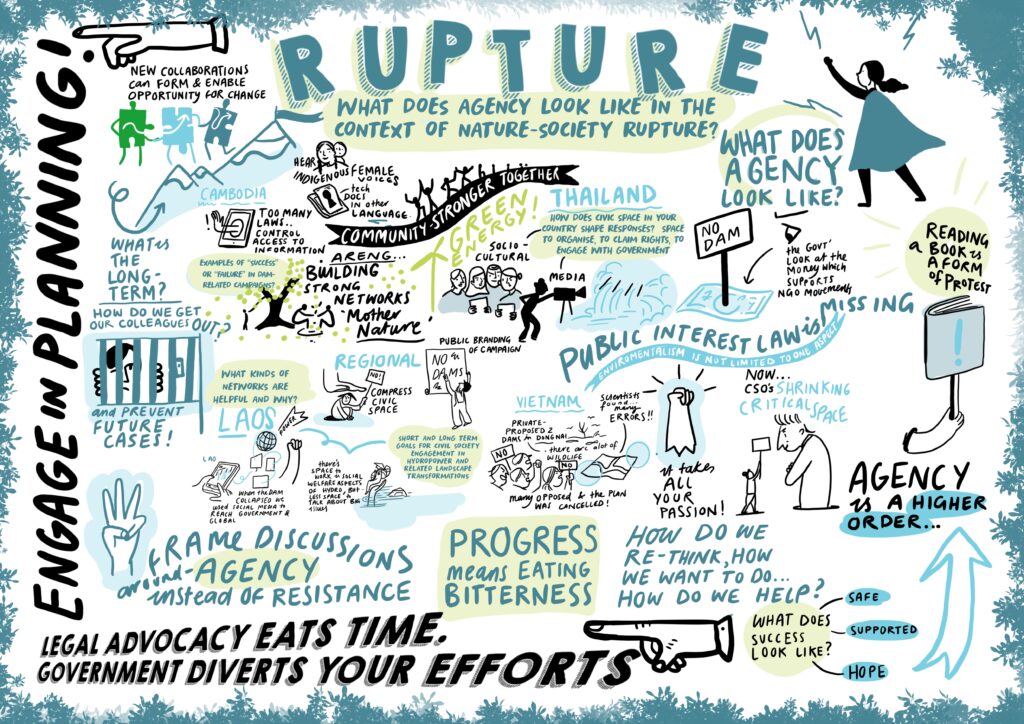
Illustration of the workshop discussion on civil society and rupture.
Over the last five years, pressure on civil society actors has increased dramatically in the Mekong region. Advocates for social and environmental justice, and the citizens they speak for, now fear arrest, intimidation and violence, as authoritarian states seek to control dissenters and critics. Take, for example, the arrests of environmental advocates in Cambodia in 2021 and Vietnam in 2022, which have served as a stark warning to those who speak out.
This rising sense of oppression goes hand in hand with new atmospheres of violence and despotic power globally—as seen in the record number of environmental defenders killed in 2021. Citizens across China and Southeast Asia are now contending with new forms of state coercion and violence. The case of Myanmar is most blatant, with the execution of four pro-democracy advocates in July 2022. Yet state power also advances through the deployment of laws to manage emerging public health and safety issues like COVID-19 and cyber-crime: conveniently, these laws enable oppressive states to silence dissent, as seen in Cambodia, Myanmar and the Philippines.
In short, as environmental and social pressures intensify in the Mekong region, it appears that governments have become increasingly sensitive to contestation. This is especially true in the context of environmental struggles, which are now more than ever struggles over political space, freedom of expression, and social justice. In this context, we find that—like the Mekong river itself, whose waters cannot be entirely controlled—potentialities and possibilities for power to be exercised by ordinary people still remain, even as controls on civil society shift and tighten.
Shrinking political space
The space for civil society to operate may be understood in terms of people’s perceptions of what political actions and expressions are possible. These openings are uneven across issues, groups, time and space: some political expressions may be possible in capital cities with few repercussions, while the same activity in an Indigenous or ethnic minority community would be suppressed by governments. Likewise, critical moments for civil society can open and close, as seen recently in Vietnam in the context of parliamentary meetings or high-level negotiations over trade agreements: these are moments of high NGO influence and political tension. Importantly, the fact that political space has become more constricted in the Mekong region in recent years does not mean this will always and everywhere be the case. Advocates continue to find pathways to work within existing spaces, pressing against their boundaries.
An increasingly important political space for civil society in the region is the legal domain. While the law can and should provide an avenue to pursue justice, it can also be used as a weapon by ruling authorities to target oppositional voices. The Vietnamese government’s use of “tax evasion” charges, for example, alongside new “financial compliance” rules for NGOs, illustrate how the law can be used instrumentally as a means of oppression. Here, critical voices are silenced using mundane domestic laws that render politics invisible and prevent international support from being channelled to advocates. The consequences for those who are targeted, and their families and communities, are devastating. As one participant at our workshop from Vietnam observed: “fighting these legal cases takes all of our time and passion”.
Laws that are purported to formalise civil society space are a double-edged sword that can also be used by states as instruments of control. A clear example is Cambodia’s 2015 “Law on Associations and Non-Government Organisations” (LANGO), which has been used to suspend organisations that contest government-backed land grabbing and resource appropriation. This, in conjunction with other silencing instruments in Cambodia’s penal code like the 2020 “Incitement to Commit a Felony”, has had a chilling effect on civil society.
In contrast, in Laos, where civil society has long been highly curtailed, the legal domain is now a key platform for NGOs and advocates to express their concerns. For example, openings have emerged for civil society to participate in dialogues with donors and the Lao National Assembly on “legal reform”. But such opportunities can also be a burden, as civil society’s limited capacity is distracted and absorbed into an endless legal-regulatory churn in Vientiane. Local NGOs observed that policy discussions in the capital have had little impact upon conditions faced by villagers in rural areas, where a UN Special Rapporteur observed a “near total lack of space for freedom of expression” after the arrests of villagers involved in land conflicts.
Agency in a constrained world
In contemplating these new constraints to civil society in the Mekong region, we must consider how agency now appears in different forms and places. We adopt the concept of agency here, as opposed to resistance, because it implies a wider repertoire for the oppressed. Broadly speaking, agency can be explored in terms of the practices, habits and ideas of actors that might transform existing institutions and social relations—or indeed reproduce them. Agency is distinct from resistance because it can be performed within dominant structures, without overtly challenging them—a notion that is akin to James Scott’s “weapons of the weak”. Viewed in this way, we observed three key domains of agency:
First, we note the power of social media to gain visibility for key issues, even though this domain has become risky for those who dare to be outspoken. In Laos, for example, urban citizens and NGOs used social media to connect and organise emergency relief in the aftermath of the 2018 Xepian Xe Nam Noy dam collapse. This generated awareness of the far-reaching devastation caused by the incident, and helped to extend assistance to displaced villagers, even through NGO-government collaborations. Yet the limits for civil society were underscored in 2019 when a young woman from southern Laos, was arrested after she posted social media commentary critical of the government’s slow and inadequate response to flood-affected communities, among other matters.
Similarly in Cambodia, social media and smartphones provide a vital means of connection for citizens who are affected by dams, as well as forest and land encroachments. Kuy Indigenous villagers in Prey Long, for example, have used communication technology to gather data and report on illegal logging, in a form of “geographic citizen science”. Five years ago, advocates in urban land disputes in Battambong also used social media to criticise the ruling elite and raise awareness of the rights of informal settlers. Yet government tolerance of such activities has declined, as signalled by the arrest of some young advocates working for the NGO Mother Nature in 2021, after their Facebook posts. Tellingly, Cambodia’s ruling party is allegedly in discussions with Chinese advisors over potential assistance to strengthen government control over its citizens’ use of social media.
Second, we observe the potential of innovative and flexible networks, which are both formal and informal. As seen in Vietnam between 2013-2018, advocates for healthy rivers developed cross-sector relationships over time, in order to achieve their goals iteratively. This approach led to the government’s cancellation of the controversial Dong Nai dams in 2015, after challenges mounted by an influential network that included researchers, civil society, and sympathetic government officials. Local government officials can provide critical support in such cases, as they are often motivated by their own personal origins in or close social ties to communities impacted by environmental damage: a distinctive dynamic in the Vietnamese setting, where government power is more decentralised. Similar hybrid networks have also been crucial for defending rivers in Thailand.
As political space contracts, we now see an increasing role for informal networks or coalitions, which adopt long-term and adaptive strategies. Being less visible means that these groups can be more nimble and flexible; they can avoid direct conflict; and they can even foster conversations with government officials or other powerful actors. This may involve the pursuit of narrowed or less radical conversations in the short term, as currently seen in Laos and Vietnam, where civil society organisations have settled for government engagements that involve neutral activities like service delivery, tree planting, or humanitarian relief. In such contexts, change can only be incremental. Yet, while tinkering around the edges of trouble, advocates can gradually build skills, trust, capacities, and room to manoeuvre.
Third, and finally, we observe agency in the production of knowledge, especially when this is driven by local villagers and their agendas. In Thailand, for example, co-producing knowledge has become a way to “fight back” against oppression, and to gain recognition for local perspectives and experiences of environmental change. This has been made famous in the method of Tai Baan research which is now providing regional inspiration: Tai Baan is a highly collaborative knowledge-making strategy that was developed in 2000 with villagers in Pak Mun, Thailand, as a way to document and communicate their experiences of a hydropower dam. A key achievement of this “knowledge advocacy” was to ensure that government officials heard villagers’ voices.
Participatory action research of this kind was also deployed around Cambodia’s Lower Sesan II dam which became operational in 2018. Oxfam, for example, trained women in water monitoring, which enabled them to lobby local authorities to address contaminated water in relocated villages. International NGOs also worked with local networks to support Indigenous communities in the dam-affected area to map and seek recognition of their traditional territories—a strategy that has strengthened local voices and identities, albeit not without challenges. Ultimately, this work helped to empower some Indigenous Bunong families to refuse forced relocation by the government, so that they could remain on their customary lands.
Rupture and the Mekong’s New Environmental Politics
It is now abundantly clear that “environmental issues are not just environmental issues in the Mekong region”, as one member of our group noted. To illustrate this, we have shared our observations of increased government controls on civil society in relation to hydropower dams, as well as in wider natural resource management and land contests in urban and rural areas.
Our findings show how the environmental frame acts as a window into the production of political space in the Mekong region today—and the results are sobering. While authorities have long considered the words “activist” and “human rights” to be highly provocative, our observations show how the envelope of provocation has widened. Criticism is barely tolerated, and government intimidation of civil society is manifesting across various scales and circumstances: from the arrests of rural villagers involved in isolated land disputes, to the silencing of NGO workers engaged in efforts to regulate and bring transparency to international markets. This new environmental politics is, if nothing else, “complex, nonlinear and undetermined”.
For local civil society advocates seeking social and environmental justice, it is now hard to think in terms of success or failure: they recognise that they are engaged in a long-term struggle. Windows of opportunity may emerge, but they are often narrow and fleeting. This means that many advocates and ordinary citizens are facing exhaustion, and emotions are running high.
Tragically too, the urgency of environmental decline and dispossession in many settings does not allow for advocates to “play the long game” on civil society and human rights in the region: many citizens are now faced with an emotional, political and material-environmental squeeze. This resonates with Saidiya Hartman’s “politics in a lower frequency”, whereby operating in highly dominated and violent spaces calls for “local, multiple, and dispersed sites of resilience”.
Ultimately, we find some hope in the Mekong region’s “low frequency politics”, in which unexpected coalitions or unusual collaborations show promise. We have now seen how knowledge advocacy and communications through social media can be mobilised for change. Yet caution is required: donors and international partners need to be aware of the new political contours of civil society in the region, especially the potential risks of doing “political work” for local citizens and collaborators.
 Facebook
Facebook  Twitter
Twitter  Soundcloud
Soundcloud  Youtube
Youtube  Rss
Rss 